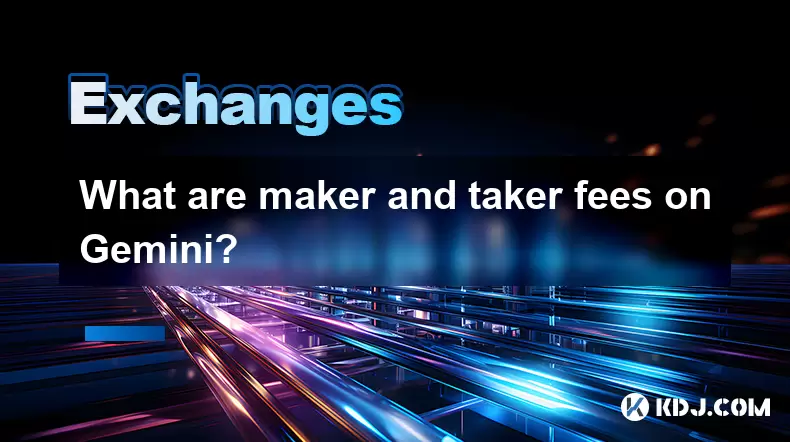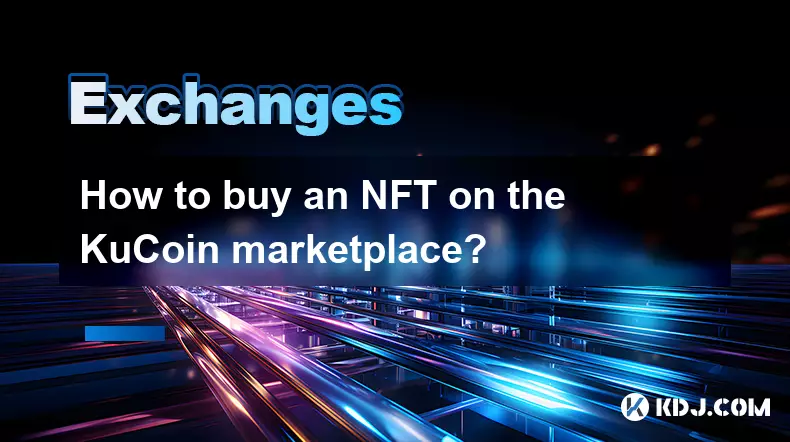-
 bitcoin
bitcoin $122288.232522 USD
0.16% -
 ethereum
ethereum $4480.662914 USD
-0.22% -
 xrp
xrp $2.962747 USD
-2.32% -
 tether
tether $1.000120 USD
-0.05% -
 bnb
bnb $1145.654223 USD
-2.07% -
 solana
solana $227.105217 USD
-1.67% -
 usd-coin
usd-coin $0.999548 USD
-0.02% -
 dogecoin
dogecoin $0.250875 USD
-2.04% -
 tron
tron $0.340654 USD
-0.49% -
 cardano
cardano $0.837968 USD
-2.52% -
 hyperliquid
hyperliquid $48.960449 USD
0.06% -
 chainlink
chainlink $22.049280 USD
-1.33% -
 ethena-usde
ethena-usde $1.000404 USD
0.02% -
 sui
sui $3.586212 USD
0.20% -
 avalanche
avalanche $29.894916 USD
-4.18%
What are maker and taker fees on Gemini?
On Gemini, maker orders (limit orders that add liquidity) have lower fees than taker orders (market orders that remove liquidity), with rates based on 30-day trading volume.
Aug 06, 2025 at 09:09 pm

Understanding Maker and Taker Fees on Gemini
Cryptocurrency exchanges like Gemini use a fee structure based on whether a user is placing a maker order or a taker order. These fees are designed to incentivize market liquidity and regulate trading behavior. When you trade on Gemini, every order you place is classified as either a maker or a taker, and the fee you pay depends on that classification. Understanding the difference between these two types of orders is essential for minimizing trading costs and optimizing your strategy.
A maker order is an order that adds liquidity to the market. This happens when you place a limit order that does not execute immediately because it’s waiting to be matched at a specific price. For example, if the current market price for Bitcoin is $30,000 and you place a limit buy order at $29,500, your order sits on the order book until someone else sells at that price. Since your order improves market depth, you are considered a maker and are typically charged a lower fee—or sometimes receive a rebate, depending on the exchange.
In contrast, a taker order removes liquidity from the market. This occurs when you place an order that executes immediately against existing orders on the book. Market orders and limit orders that cross the spread are considered taker actions. For instance, if you place a market buy order for Ethereum, you instantly consume an existing sell order. Because you are taking liquidity away, you are labeled a taker and are charged a higher fee than makers.
Gemini’s Fee Structure for Makers and Takers
Gemini operates on a tiered fee schedule based on your 30-day trading volume and whether you are using the ActiveTrader platform or the standard Gemini.com interface. On the ActiveTrader platform, fees are generally lower and more transparent. As of the latest update, maker fees on ActiveTrader can be as low as 0.10%, while taker fees are typically 0.20%. These rates may decrease further for users with very high trading volumes.
For users on the standard Gemini platform (not ActiveTrader), fees are often higher and may include additional spreads. For example, buying crypto with a debit card or bank transfer may incur a flat fee or percentage-based charge on top of the spread, which effectively increases the taker cost. It's important to note that ActiveTrader is required to access the lower maker-taker fee model; otherwise, users are subject to retail pricing, which does not distinguish between maker and taker roles in the same way.
To view your current fee tier, log in to your Gemini account, navigate to the 'Fees' section under 'Trading', and check the ActiveTrader fee schedule. Your tier is determined by your total trading volume (in USD equivalent) over the past 30 days across all pairs. Higher volume leads to lower fees for both makers and takers.
How to Place a Maker Order on Gemini
To ensure your order qualifies as a maker, you must place a limit order that does not immediately execute. Follow these steps:
- Log in to your Gemini ActiveTrader account.
- Select the trading pair you want to trade (e.g., BTC/USD).
- Choose the 'Limit' order type.
- Enter a price that is better than the current market price—for a buy order, set a price below the current lowest ask; for a sell order, set a price above the current highest bid.
- Enter the quantity you wish to trade.
- Click 'Buy' or 'Sell' to place the order.
If your order does not fill immediately and appears in the order book, it is classified as a maker order. You can verify this in your order history, where the fee will reflect the maker rate. Avoid placing orders too close to the market price, as they may execute instantly and become taker orders.
How to Place a Taker Order on Gemini
A taker order executes immediately by matching with existing orders. To place one:
- Access Gemini ActiveTrader.
- Choose your desired trading pair.
- Select 'Market' or 'Limit' order type.
- If using a market order, simply enter the amount to buy or sell—the system will execute at the best available price.
- If using a limit order, set a price that crosses the spread—for example, set a buy limit price equal to or higher than the lowest ask.
- Confirm the transaction.
Your order will execute instantly, and the fee charged will be the taker rate. In your transaction history, you’ll see the taker fee applied, which is higher than the maker fee. Market orders are always taker orders because they remove liquidity immediately.
Viewing and Calculating Fees on Gemini
To see exactly how much you’re paying in fees:
- Go to your 'Orders' or 'Transactions' tab in the Gemini interface.
- Locate the completed trade.
- Click on the trade details to view the fee breakdown.
- The fee will be listed in either USD or the traded cryptocurrency.
- Confirm whether the fee matches the maker or taker rate based on your order type.
You can also use Gemini’s fee calculator (available in the help center) to estimate costs before placing an order. Input the order size, price, and type to see projected fees. This helps in deciding whether to place a limit order (maker) or accept the higher cost of a taker order for immediate execution.
Common Misconceptions About Maker and Taker Fees
Some users assume that all limit orders are maker orders, but this is not always true. If your limit order is priced aggressively—for example, a buy limit set at or above the current ask—it will execute immediately and be treated as a taker. Similarly, a sell limit order at or below the current bid becomes a taker. The key factor is whether the order adds liquidity or removes it, not just the order type.
Another misconception is that maker fees are always free or negative (a rebate). While some exchanges offer maker rebates, Gemini currently charges a small positive fee for makers, though it remains lower than the taker fee. Always check the latest fee schedule, as rates can change based on market conditions or promotional periods.
Frequently Asked Questions
Can I switch from the standard Gemini platform to ActiveTrader to get lower fees?Yes. You can access ActiveTrader by logging into your Gemini account and navigating to the trading interface. ActiveTrader is available to all users and offers the maker-taker fee model. You must place orders directly on the ActiveTrader platform to benefit from lower fees.
Do maker and taker fees apply to all trading pairs on Gemini?Yes. The maker-taker model applies to all supported trading pairs on Gemini ActiveTrader, including BTC/USD, ETH/USD, and stablecoin pairs. Fees are consistent across pairs within the same tier, though trading volume is aggregated across all pairs for tier calculation.
Why was I charged a taker fee even though I used a limit order?This happens when your limit order executes immediately by matching with an existing order. For example, placing a buy limit at the current ask price will fill instantly, making it a taker order. To ensure a maker fee, place your limit order away from the current market price so it rests on the order book.
Are there any ways to reduce or avoid taker fees on Gemini?The most effective way is to use limit orders strategically placed to add liquidity. Avoid market orders and aggressive limit pricing. Increasing your 30-day trading volume can also move you into a lower fee tier, reducing both maker and taker fees.
Disclaimer:info@kdj.com
The information provided is not trading advice. kdj.com does not assume any responsibility for any investments made based on the information provided in this article. Cryptocurrencies are highly volatile and it is highly recommended that you invest with caution after thorough research!
If you believe that the content used on this website infringes your copyright, please contact us immediately (info@kdj.com) and we will delete it promptly.
- BlockDAG, DOGE, HYPE Sponsorship: Crypto Trends Shaping 2025
- 2025-10-01 00:25:13
- Deutsche Börse and Circle: A StableCoin Adoption Powerhouse in Europe
- 2025-10-01 00:25:13
- BlockDAG's Presale Buzz: Is It the Crypto to Watch in October 2025?
- 2025-10-01 00:30:13
- Bitcoin, Crypto, and IQ: When Genius Meets Digital Gold?
- 2025-10-01 00:30:13
- Stablecoins, American Innovation, and Wallet Tokens: The Next Frontier
- 2025-10-01 00:35:12
- NBU, Coins, and Crypto in Ukraine: A New Yorker's Take
- 2025-10-01 00:45:14
Related knowledge

How to close my position in KuCoin Futures?
Oct 01,2025 at 07:54pm
Understanding Position Closure in KuCoin FuturesTrading futures on KuCoin requires a clear understanding of how to manage open positions. Closing a po...

How to find the contract address for a token on KuCoin?
Sep 30,2025 at 09:00pm
Finding the Contract Address on KuCoin1. Log into your KuCoin account through the official website or mobile application. Navigate to the 'Markets' se...

How to set up SMS verification on my KuCoin account?
Oct 03,2025 at 12:36am
How to Enable SMS Verification on Your KuCoin AccountSecuring your cryptocurrency exchange account is essential, especially on platforms like KuCoin w...

How to update the KuCoin app to the latest version?
Oct 03,2025 at 02:18am
How to Update the KuCoin App: A Step-by-Step GuideKeeping your KuCoin app updated ensures access to the latest security features, trading tools, and u...

How to buy an NFT on the KuCoin marketplace?
Oct 02,2025 at 10:19pm
Accessing the KuCoin NFT Marketplace1. Log in to your KuCoin account through the official website or mobile application. Ensure that two-factor authen...

How to create a sub-account on KuCoin?
Oct 03,2025 at 10:18pm
Accessing the KuCoin Dashboard1. Navigate to the official KuCoin website and log in using your registered email and password. Two-factor authenticatio...

How to close my position in KuCoin Futures?
Oct 01,2025 at 07:54pm
Understanding Position Closure in KuCoin FuturesTrading futures on KuCoin requires a clear understanding of how to manage open positions. Closing a po...

How to find the contract address for a token on KuCoin?
Sep 30,2025 at 09:00pm
Finding the Contract Address on KuCoin1. Log into your KuCoin account through the official website or mobile application. Navigate to the 'Markets' se...

How to set up SMS verification on my KuCoin account?
Oct 03,2025 at 12:36am
How to Enable SMS Verification on Your KuCoin AccountSecuring your cryptocurrency exchange account is essential, especially on platforms like KuCoin w...

How to update the KuCoin app to the latest version?
Oct 03,2025 at 02:18am
How to Update the KuCoin App: A Step-by-Step GuideKeeping your KuCoin app updated ensures access to the latest security features, trading tools, and u...

How to buy an NFT on the KuCoin marketplace?
Oct 02,2025 at 10:19pm
Accessing the KuCoin NFT Marketplace1. Log in to your KuCoin account through the official website or mobile application. Ensure that two-factor authen...

How to create a sub-account on KuCoin?
Oct 03,2025 at 10:18pm
Accessing the KuCoin Dashboard1. Navigate to the official KuCoin website and log in using your registered email and password. Two-factor authenticatio...
See all articles










































































